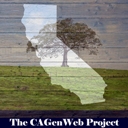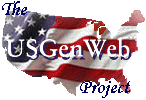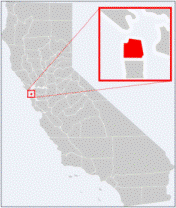Some
of the early events in San Francisco's
history include: the discovery of San
Francisco Bay in 1769 by Don Gapar de
Portola; the establishment of Mission
Dolores in 1776; the founding of the
Presidio in 1776; the first home built by
Captain William A. Richardson in 1835;
A summary and timeline of some of the
major events follow. The Counties
and Courthouses book by the
Historical Activities Committee, 1964,
contains more historical information about
San Francisco.
1840s
- 1847: The city's first
newspaper the California Star began in
1847 and later merged with the Alta.
- 1848: Gold was found in
the American River 1848 starting a
population explosion in San Francisco
that increased the population from a few
hundred in 1848 to over 30,000 by 1849.
Between 1849 and 1951 there were six
major fires that destroyed the City
almost faster than it could be rebuilt.
One of these fires is described in a transcribed letter
from 1849.
1850s
The 1850s
were a time of building and coming to
grips with the population explosion.
- San Francisco County was
formed and the San Francisco City
Charter was approved by the California
Legislature.
- 1850 Transbay ferry
service began with the establishment of
a route between San Francsico and the
Oakland Estuary.
- 1850 Yerba Buena Cemetery
opened.
- 1851 Crime gets out of
control. The first Committee of
Vigilance was established.
- 1854 Lone Mountain
(Laurel Hill) cemetery established.
- 1856 The City and County
of San Francisco were combined. San
Mateo was split off as a separate
county.
- 1858 The Overland Stage
begins between Sanfrancisco and the
East.
1860s
The 1860s
brought continued population growth with
the Pony Express and railroad connecting
San Francisco to the East Coast. Some of
the highlights include:
- 1860 The Pony Express
began service from St. Joseph, Missouri
to San Francisco.
- 1860 The "Pioche
Railroad" was started by the Market
Street Railway Company, which graded
Market Street. This road at first was
operated by steam dummies, later by
means of horses.
- 1861 Fort Point was
completed. It was built to protect San
Francisco from some one who never came.
The fort was never fired on nor did it
ever have to defend the Gate.
- 1861 Pony Express ceased
opetions 19 months after it began.
- 1862 Telegraph services
was established between San Francisco
and New York.
- 1864 San Francisco
Railroad line (predecessor to CalTrain)
was completed to San Jose.
- 1865 The Dramatic
Chronical (later The Chronicle) was
first published.
- 1865 The Examiner was
first published.
- 1865 A great earthquake
hit San Francisco causing extensive
damage.
- 1868 A magnitude 7.0
earthquake struck along the Hayward
fault causing much damage and loss of
life.
- 1869 The first westbound
train arrived in San Francsico.
1870s
The 1870s
were a time of city expansion with the
Golden Gate park being created and the
first cable car system started. By the
late 1870s San Francisco began to suffer
difficult and bitter economic times. The
white workers blamed the chinese for their
high unemployment rate. Chinese withdrew
into what we now call Chinatown. The
following highlights some of the events.
- 1870 San Francisco
became the tenth largest city in the
United States.
- 1870 Golden Gate park
was created.
- 1871 Yerba Buena
Cemetery removed.
- 1873 Andrew S. Hallidie
tested his first cable car system near
the top of Nob Hill at Clay and Jones
streets and the next month started
public service.
- 1876 Southern Pacific
Railroad line connecting Los Angeles and
San Francisco was completed.
- 1876 Diptheria
epidemic.
- 1877 Angry mobs killed
4 and wounded 18 when more Chinese
immigrants arrived.
1880s
The Indian
Wars of the 1870s and 1880s resulted in
additional growth of the Presidio.
Soldiers stationed here saw action against
the Modoc Indians in the Lava Beds of
northern California and against the Apache
Indians in the southwest. In the 1880s a
large-scale tree planting and post
beautification program was started. Some
of the highlights from the 1880s are
listed below.
- 1880 George Hearst
accepted a small daily newspaper, the
San Francisco Examiner, as payment for a
gambling debt. The elder Hearst, now a
U.S. senator from California, had little
interest in the newspaper business as
such, but the event proved pivotal for
his son. In the mid-1880s, young Will
(William Randolf Hearst), a Harvard
student at the time, wrote his father a
now-famous letter requesting that he be
permitted to take over the Examiner.
- 1880 The Irish make up
nearly one-third of the City's
population.
- 1886 Anti-Chinese mobs
in Seattle force about 200 Chinese to
flee to San Francisco.
- 1887 A snowstorm
covered the entire city making San
Francisco a winter wonderland.
1890s
The 1890s
brought a depression although San
Francisco continued some growth and
building. Some of the highlights from this
period follow.
- 1890 USS San Francisco, a
4088-ton protected cruiser, was built at
San Francisco, California, and
commissioned in November 1890. She
served in the Pacific until 1893, then
steamed to the Atlantic. Operations
followed in the North and South
Atlantic, and in European waters. During
the Spanish-American War, in 1898, San
Francisco was stationed off Cuba
- 1892 Sierra Club was
founded with 182 members and John Muir
as president.
- 1898 American
Anti-Imperialist League founded. It was
created to protest the annexation of
Cuba, Puerto Rico, Guam, and the
Philippines after the Spanish-American
War, the Anti-Imperialist League was the
first national anti-imperialist
organization formed in the United
States.
- 1898 The Ferry Building
was built. By the early 1930s it was The
Ferry Building was the second busiest
transportation terminal in the world.
1900s
One of the
wonderful aspects of the
turn-of-the-century era was the multitude
of grandious schemes for the development
of California. In the early 1900's, the
country had rebounded from the depression
of the 1890's, so a renewed sense of
optimism was the mood of the day although
in 1906 a major earthquake caused much
death and destruction in the City.
Following are some hightlights from this
era.
- 1903 The Commonwealth
Club of California was founded in 1903
by San Francisco Chronicle editorial
writer Edward F. Adams.
- 1905 A coast railroad
from San Francisco to Santa Cruz was
created. It was initially called the
Ocean Shore Electric Railway. Initial
work began in 1905.
- 1906 A major earthquake
struck the San Francisco Bay Area.
- 1907 San Francisco
Streetcar strike.
- 1909 John Muir led a
movement to save the Hetch Hetchy Valley
from ruin at the hands of the City and
County of San Francisco who wanted the
valley for a municipal water supply.
1910s
The period
from 1910 to 1919 was one of continued
immigration and growth of San Francisco
although mared by World War I. The
following are some hightlights from this
era.
- 1910 Angel Island opened.
For 30 years, Angel Island served as a
point of entry to the United States for
many immigrants. Like Ellis Island in
New York, it processed the entry of
people from different parts of the
world. Unlike Ellis Island, it also
served as a prison for hundreds of
Chinese immigrants.
- 1911 Women given the
right to vote in California.
- 1912 Souther Pacific
Railroad terminal built at Third and
Townsend streets in anticipation of the
1915 Exposition.
- 1914-1918 WWI
- 1915 Palace of Fine Arts
created by architect Bernard R. Maybeck
for the Panama-Pacific International
Exposition.
- 1915 Panama Pacific
International Exposition
- 1918 Great Flu epidemic
- 1918 The end of the war
to end all wars. Soldiers came home with
a victory parade down Market Street, and
the City looked forward to an era of
peace and prosperity
1920s
The Roaring
'20s as they are commonly referred to.
Despite prohibition laws San Francisco
remained the wettest city in the West.
Some of the highlights from this era
follow.
- 1920 The Great Highway
and Ocean Beach Esplanade completed.
More than 50,000 people joined in the
festivities and celebration.
- 1921 Fatty Arbuckle
arrested for the murder of Virginia
Rappe after a lavish party at the St.
Francis Hotel.
- 1922 Statute took away
citizenship from any American woman who
married a man not elibilbe for
citizenship
- 1929 Black Tuesday,
stock market crashed.
1930s
The early
30s were years of the great depression
however by the mid to late 30s the worst
had passed. The great period of ferry
transit reached its peak in the 1930's,
when 60 million persons crossed the bay
annually, along with 6 million autos.
Highlights from this era follow.
- 1933 San Francisco Ballet
Company founded.
- 1934 San Francisco
Maritime strike began May 9th. Running
battles between unionists and police
began July 3rd with July 5th known as
"Bloody Thursday".
- 1935 San Francisco Museum
of Art opens under the leadership of
founding directory Grace L. McCann
Morley in the fourth floor of the War
Memorial Veterans Building.
- 1935 City College of San
Francisco, a public two-year college,
opens.
- 1936 San
Francisco-Oakland Bay Bridge opens.
- 1926 Herb Caen landed a
job writing a column for the San
Francisco Chronicle.
- 1937 Golden Gate Bridge
opens.
- 1939 Golden Gate
Internation Exposition and fair, also
known as Treasure Island.
1940s
The first
half of the 40s saw men and women from
every walk of life flocking to the
shipyards to find work and support the war
effort. San Francisco was referred to as
"Baghdad by the Bay" by Herb Caen. It was
possible to drink 24 hours a day. Sally
Stanford the famous madam had a hugh house
on Russion Hill and her girls were like
socialites. Some highlights from this era
follow.
- 1939-1945 WWII. During
the war 120,000 Japanese aliens and
American citizens with Japanese faces
were removed from the theirhomes in
California, Oregon, Washington and taken
to internment camps. Of those, 18,000
were from the San Francisco Bay Area.
- 1940 The 2nd Golden Gate
Internation Exposition and fair was held
- 1940 Navy purchases
Hunter's Point.
- 1945 UN Charter creating
the United Nations was signed in San
Francisco.
|


